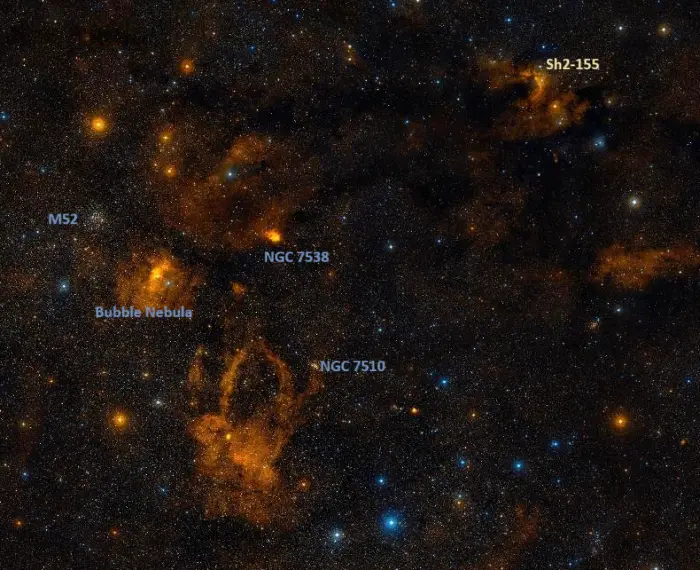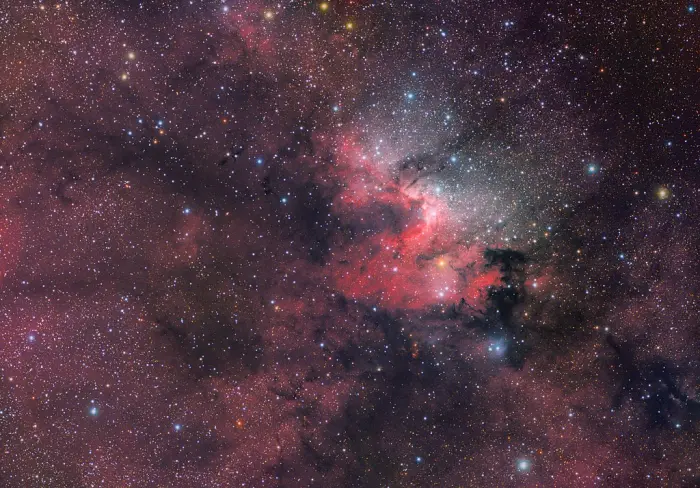The Cave Nebula is an emission nebula located approximately 2,400 light-years away in the northern constellation Cepheus. With an apparent magnitude of 7.7 and an apparent size of 50 by 30 arcminutes, it can be observed in medium telescopes. The diffuse nebula is listed as Sharpless 155 (Sh2-155) in the second Sharpless catalogue and as Caldwell 9 (C9) in the Caldwell catalogue of deep sky objects visible in amateur telescopes.
The Cave Nebula lies within a larger complex of emission, reflection and dark nebulae in the far northern sky. It is an H II region, composed of ionized hydrogen, which shows evidence of recent star formation. It has a radius of 35 light-years and an absolute magnitude of 16.
The nebula is part of the larger Cepheus OB3 stellar association. It appears at the edge of the Cepheus B cloud, a cloud of molecular hydrogen located within the larger Cepheus molecular cloud. The young stars in the Cepheus OB3 association are responsible for ionizing the nebula.

This image was obtained with the wide-field view of the Mosaic camera on the Mayall 4-meter telescope at Kitt Peak National Observatory. Sh2-155, informally known as the “cave nebula,” is dark cloud of gas embedded in a giant emission nebula. The top edge of the cloud is illuminated by several hot, massive (OB) stars that are part of the Cepheus OB3 assocation. The image was generated with observations in Hydrogen alpha (red), Sulphur [S II] (blue) and I (orange) filters. In this image, North is left, East is down. Image credit: T.A. Rector (University of Alaska Anchorage) and H. Schweiker (WIYN and NOIRLab/NSF/AURA) (CC BY 4.0)
Observations with the Spitzer Space Telescope and the Chandra X-ray Observatory in 2009 confirmed that massive stars like HD 217086 can indeed often trigger star formation.
Chandra detected strong X-ray emission from the young stars in the Cepheus B cloud, while Spitzer showed the protoplanetary disks around the stars that are still in the process of forming.
The stars in the inner portion of Cepheus B have an estimated age of only 1 million years. Most of them (70 – 80%) still have protoplanetary disks. Those in the intermediate layer, just next to Cepheus B, are around 2 – 3 million years old and only around 60% of them still have disks. The stars in the outer layer are 3 – 5 million years old and only 30% of them have protoplanetary disks. The age increase of the young stars in the region corresponds to the model of triggered star formation.

Cave Nebula (Caldwell 9), image credit: Adam Block/Mount Lemmon SkyCenter/University of Arizona (CC BY-SA 4.0)
Facts
The name Cave Nebula had previously applied to the nebula Cederblad 201, which also lies in the constellation Cepheus. Sh2-155 was named the Cave Nebula by the British amateur astronomer Sir Patrick Moore, who included it in his Caldwell catalogue. Moore presumably named the nebula the Cave because of the prominent curved arc visible in long-exposure images, that resembles the mouth of a cave. The arc is an active stellar nursery.
The first known mention of the Cave Nebula is in the Sharpless catalogue of H II regions, published by the American astronomer Stewart Sharpless in 1959. Sharpless captured the nebula on photographic plates and listed it as the 155th object in his second catalogue (Sh2-155).

The Cave Nebula in the Hubble Palette (Sii, Ha, Oiii). Image: Wikimedia Commons/ Urmymuse (CC BY-SA 4.0)
Location
The Cave Nebula is relatively easy to find because it appears in the region between two prominent asterisms, Cassiopeia’s W and the House of Cepheus.
Schedar and Caph, the rightmost stars of Cassiopeia’s W, can be used to find Alderamin, the brightest star in Cepheus. Alderamin is the brightest star along the imaginary line extended from Schedar through Caph. It appears at the base of the stick house asterism that dominates the constellation Cepheus.
The Cave Nebula appears on the same imaginary line, a little less than halfway from Caph to Alderamin.

The location of the Cave Nebula (C9), image: Stellarium
The nebula appears in the same region of the sky as the brighter and better-known Bubble Nebula (NGC 7635) and the open cluster Messier 52 in the constellation Cassiopeia. Other deep sky objects in the same area include the Dormouse Cluster (Arrowhead Cluster, NGC 7510) and the star-forming region NGC 7538 in Cepheus.

The Cave Nebula, Bubble Nebula, and Messier 52, image credit: ESO/Digitized Sky Survey 2 (CC BY 4.0)
The Cave Nebula is one of the most difficult Caldwell objects to observe because of its low surface brightness. It is a low contrast object and requires exceptionally good viewing conditions and a medium-sized telescope. A nebula filter can help improve the view.
The best time of the year to observe the Cave Nebula and other deep sky objects in Cepheus is during the month of November, when the constellation appears higher in the sky in the early evening. Cepheus is visible for most of the year for observers in the northern hemisphere. At declination +62°29’, the Cave Nebula never rises for observers south of the latitude 26-27° S.
Cave Nebula – Caldwell 9
| Constellation | Cepheus |
| Object type | H II region |
| Right ascension | 22h 57m 17.14s |
| Declination | +62° 28′ 33.4″ |
| Apparent magnitude | 7.7 |
| Absolute magnitude | 16 |
| Apparent size | 50.0’ x 30.0’ |
| Distance | 2,400 light-years (725 parsecs) |
| Radius | 35 light-years |
| Names and designations | Cave Nebula, Sh2-155, Caldwell 9, LBN 529, LBN 110.11+02.44 |
Images

A mysterious, yawning mouth of gas and dust gives Caldwell 9 its popular nickname, the Cave Nebula. The nebula is actually part of a much larger cloud of gas and dust called Cepheus B, named after its home constellation, Cepheus. This image of Caldwell 9, captured by Hubble’s Wide Field and Planetary Camera 2, shows just a small portion of the nebula near the mouth of the cave. The Cave Nebula is an emission nebula, formed of gases that emit their own light. The bright arc that forms the mouth of the cave is an active birthplace for stars, known as an H II region, where hot clouds of atomic hydrogen have become ionized. Caldwell 9 is tantalizing to researchers because, according to radio and near-infrared studies of this nebula, the area is bursting with young, hot stars popping into existence. Investigating such regions of star birth helps astronomers learn more about how stars begin their lives. Hubble’s Wide Field and Planetary Camera 2 imaged this region of Caldwell 9 in 1995 to search for signs of planet-forming disks around young stars in the nebula, similar to disks Hubble had previously spotted in the Orion Nebula (M42). Image credit: NASA, ESA and K. Stapelfeldt (Jet Propulsion Laboratory); Processing: Gladys Kober (NASA/Catholic University of America) (CC BY 2.0)

Sh2-155 – Cave Nebula in Cepheus by amateur equipment. Blue reflection nebula vdB 155 is present at the lower right. LDN1215 an LDN1214 are protruding in from the right over top of vdB 155. Image: Wikimedia Commons/Hewholooks (CC BY-SA 3.0)

A complex of colorful nebulae surround the central feature commonly called the Cave Nebula (Sh2-155) in this 2 panel mosaic captured through both narrowband and broadband filters. Image credit: Nico Carver (NebulaPhotos.com) (CC BY-SA 2.0)

The Cave Nebula, credit: Wikimedia Commons/Keesscherer (CC BY-SA 4.0)